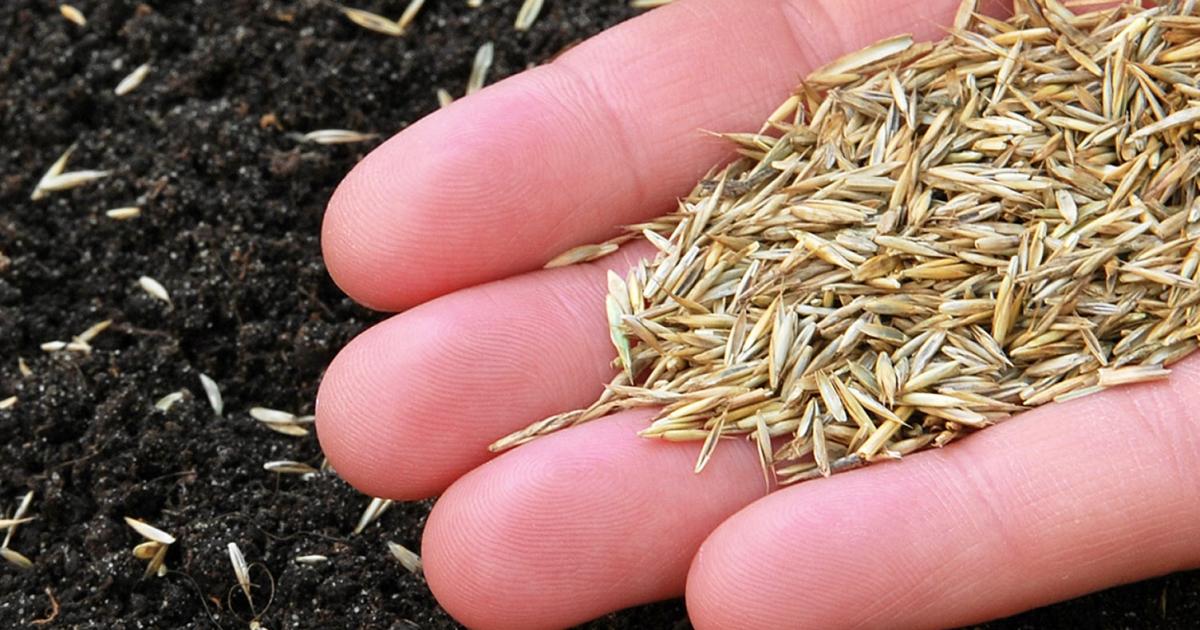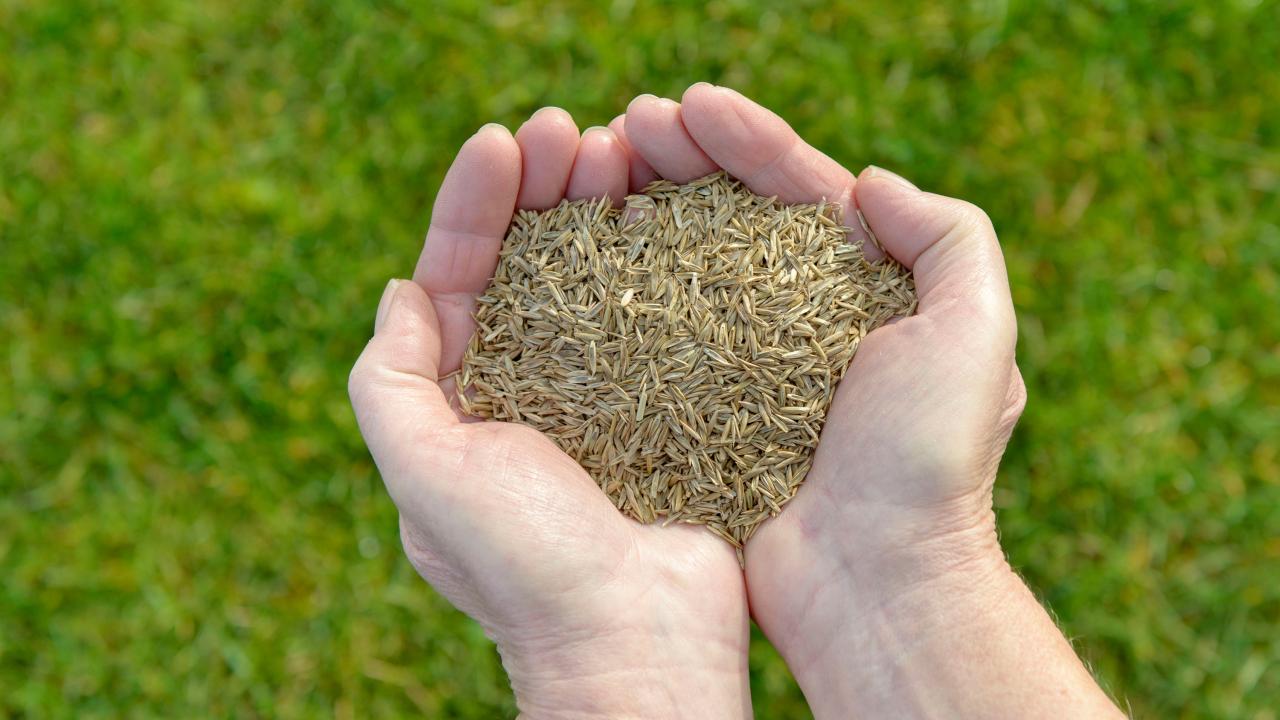Timing Is Everything: When to Sow Grass Seed for a Lush and Green Lawn – this age-old adage holds true when it comes to achieving a thriving lawn. The success of your grass seed germination hinges on the delicate balance of soil temperature, seed viability, and the timing of your efforts.
A little knowledge about the ideal sowing windows for your region can significantly impact the outcome, ensuring a vibrant, healthy lawn for years to come.
Understanding the ideal sowing windows for your region is paramount. Factors like rainfall patterns, frost dates, and soil temperature all play a role in determining the best time to sow your grass seed. This article will delve into the critical aspects of timing, providing you with the knowledge to make informed decisions for a successful lawn establishment.
The Importance of Timing: Timing Is Everything: When To Sow Grass Seed For A Lush And Green Lawn
Timing is everything when it comes to sowing grass seed. The ideal time for successful germination depends largely on the soil temperature. Understanding this relationship is crucial for achieving a lush and vibrant lawn.
Soil Temperature and Grass Seed Germination
Soil temperature plays a vital role in the germination process. Grass seeds need a specific temperature range to sprout and develop roots. This temperature range varies depending on the grass type, but generally, most cool-season grasses prefer soil temperatures between 50°F and 70°F (10°C and 21°C).
For optimal germination, the soil temperature should be consistently within this range.
Impact of Temperature Fluctuations on Seed Viability
Fluctuating temperatures can significantly impact seed viability. If the soil temperature drops below the minimum germination threshold, the seed may not germinate at all. Conversely, if the temperature rises above the optimal range, the seed may experience heat stress, reducing its chances of successful germination.
Consequences of Sowing Seeds Too Early or Too Late
Sowing grass seeds too early or too late can have negative consequences.
- Sowing too early:If the soil temperature is too cold, the seeds may not germinate, or they may germinate slowly and be susceptible to disease.
- Sowing too late:If the soil temperature is too hot, the seeds may dry out quickly, or they may germinate poorly due to heat stress.
Optimal Sowing Seasons
Timing is crucial for a successful lawn establishment, and understanding the optimal sowing seasons for your region is key. Different climates have varying ideal windows for grass seed germination and growth, influenced by factors like temperature, rainfall, and frost dates.
Recommended Sowing Months by Region
The recommended sowing months vary depending on the climate and geographic location. Here’s a table outlining the optimal sowing windows for different regions in the United States:| Region | Recommended Sowing Months ||—————–|————————–|| North | Early Spring (March-May) || | Late Summer (August-September) || South | Early Spring (February-April) || | Late Summer (August-October) || West Coast | Early Spring (February-May) || | Late Summer (August-October) |
Just like timing is crucial for achieving a lush and green lawn, the success of growing roses from cuttings hinges on proper timing. When to take cuttings and how to prepare them for planting are critical steps, as outlined in The Ultimate Guide to Growing Roses from Cuttings: Tips You Need to Know.
Similar to choosing the right time to sow grass seed, understanding the ideal conditions for rooting rose cuttings will maximize your chances of success and ensure a beautiful, blooming rose garden.
Factors Influencing Sowing Timing
Several factors influence the optimal sowing time in specific locations:* Rainfall patterns:Adequate moisture is crucial for seed germination and early growth. Sowing during periods with consistent rainfall or during times when irrigation is readily available will enhance success.
Frost dates
Grass seed needs warm temperatures to germinate and establish. Sowing before the last frost date can lead to seed damage or poor germination. Conversely, sowing too late in the season, when frost is approaching, can hinder establishment.
Temperature
Grass seeds need warm temperatures to germinate and establish. For example, cool-season grasses, such as Kentucky bluegrass, thrive in cooler temperatures and are best sown in the spring or fall. Conversely, warm-season grasses, such as Bermuda grass, prefer warmer temperatures and are best sown in the late spring or early summer.
Preparing the Soil

A healthy lawn starts with healthy soil. Just as a house needs a strong foundation, your grass needs a fertile and well-drained base to thrive. This is where soil preparation comes into play, ensuring your grass seed has the best possible chance to germinate and establish a robust root system.
Soil Testing
Understanding the composition of your soil is crucial. Soil testing reveals the pH level and nutrient content, providing valuable insights into what your soil needs to support healthy grass growth. * pH Level:The pH scale measures acidity or alkalinity, with a range of 0 to 14.
Grass prefers a slightly acidic pH between 6.0 and 7.0. If the soil is too acidic, it can hinder nutrient uptake, leading to stunted growth. Alkaline soil can also cause problems, making it difficult for certain nutrients to be absorbed.
Nutrient Levels
Soil tests reveal the levels of essential nutrients like nitrogen, phosphorus, and potassium, which are vital for grass growth. A deficiency in any of these nutrients can lead to yellowing, thinning, and overall weakness.
Preparing the Soil for Optimal Seed Germination
Once you have the soil test results, you can start preparing the soil for optimal seed germination.
Just as timing is crucial for achieving a lush, green lawn, it’s also essential for successful plant propagation. For instance, How to Propagate Ivy in Just a Few Days – Quick and Easy Steps provides a clear guide on the best time to take cuttings and ensure optimal root development.
Similarly, understanding the ideal season for sowing grass seed, whether in spring or fall, can significantly impact the health and vigor of your lawn.
1. Remove Existing Vegetation
Clear the area of existing grass, weeds, and debris. This can be done manually or with a sod cutter.
2. Till or Rake the Soil
Loosen the soil to a depth of 4-6 inches to allow for proper root development. You can use a tiller for larger areas or a rake for smaller patches.
3. Amend the Soil
Based on your soil test results, incorporate amendments to adjust the pH and nutrient levels.
4. Level the Soil
Ensure a smooth and even surface for consistent seed distribution and germination. Use a rake or a landscaping tool to create a level surface.
5. Water Thoroughly
After amending and leveling the soil, water thoroughly to settle the soil and create a moist environment for seed germination.
Essential Soil Amendments
- Lime:Used to raise the pH level of acidic soil. It improves nutrient availability and promotes healthy growth.
- Sulfur:Used to lower the pH level of alkaline soil. It increases the availability of nutrients and helps correct imbalances.
- Compost:A natural, organic amendment that improves soil structure, drainage, and fertility. It provides essential nutrients and promotes beneficial microbial activity.
- Fertilizers:Provide essential nutrients like nitrogen, phosphorus, and potassium to support healthy grass growth. Choose a fertilizer specifically formulated for lawns, following the recommended application rates.
Sowing Techniques

Once you’ve prepped your soil, the next step is to sow your grass seed. The method you choose will depend on the size of your lawn, the type of grass you’re planting, and your personal preference.
Seed Distribution Methods
The method you use to distribute your seed can have a significant impact on the success of your lawn. Here are three common methods:
- Broadcasting: This is the simplest method, involving scattering seed by hand over the prepared soil. While easy, it can be challenging to ensure even distribution, especially over large areas. This method is best suited for small lawns.
- Overseeding: This method involves scattering seed over an existing lawn. It’s a great way to thicken up thin spots or introduce a new variety of grass. However, overseeding requires careful preparation to ensure the seed has good contact with the soil.
- Seed Spreader: A seed spreader is a mechanical device that distributes seed evenly across the lawn. This method is ideal for large areas and ensures consistent seed distribution. Different types of seed spreaders are available, including rotary spreaders and drop spreaders.
Rotary spreaders use a spinning disc to distribute seed, while drop spreaders use a series of hoppers to drop seed at regular intervals.
Seeding Depth
The depth at which you sow your seed is crucial for germination. If the seed is sown too shallow, it may dry out before it can germinate. If it’s sown too deep, it may not have enough energy to reach the surface.
The general rule of thumb is to sow seed at a depth of two to three times the diameter of the seed.
Here is a visual illustration demonstrating the proper seeding depth for various grass types:[Insert visual illustration here]For example, Kentucky bluegrass seeds are typically 1/16 inch in diameter, so they should be sown at a depth of 1/8 to 3/16 inch.
Fescue seeds are typically 1/8 inch in diameter, so they should be sown at a depth of 1/4 to 3/8 inch.
Ensuring Even Seed Distribution
To ensure even seed distribution, follow these tips:
- Use a seed spreader: A seed spreader is the most reliable way to ensure even seed distribution.
- Walk in a straight line: If you’re broadcasting seed by hand, walk in a straight line and overlap each pass by about 50%.
- Check for bare spots: After you’ve finished sowing, walk across your lawn and look for any bare spots. If you see any, add more seed to those areas.
- Lightly rake the seed into the soil: After sowing, lightly rake the seed into the soil to ensure good contact. This will also help to prevent the seed from being blown away by the wind.
Post-Sowing Care
Once you’ve sown your grass seed, the real work begins. Proper post-sowing care is crucial for ensuring a lush, healthy lawn. This involves a combination of consistent watering, appropriate fertilization, and weed control.
Watering
Consistent watering is paramount for the germination and establishment of new grass. Newly sown seeds need moisture to sprout and develop roots. The goal is to keep the soil consistently moist but not soggy.
- Frequency:Water deeply but infrequently, aiming for a thorough soaking every few days, rather than light sprinklings daily. The exact frequency will depend on factors like weather, soil type, and seed variety.
- Depth:The water should penetrate at least 2 inches deep to encourage deep root growth.
- Timing:Early morning watering is ideal, as it allows the moisture to soak in before the sun evaporates it. Evening watering can lead to fungal diseases if the grass doesn’t dry properly.
Fertilizing
Starter fertilizer is a crucial component of post-sowing care. It provides essential nutrients that help the new grass seedlings develop a strong root system and establish themselves.
- Importance:Starter fertilizer is formulated with a high phosphorus content, which promotes root growth. It also contains nitrogen for leaf growth, but in a lower concentration than typical lawn fertilizers.
- Application:Apply starter fertilizer according to the manufacturer’s instructions, typically a few weeks after sowing.
- Timing:Avoid applying fertilizer immediately after sowing, as it can inhibit seed germination.
Weed Control
While pre-emergent herbicides can help prevent weed growth, some weeds may still emerge after sowing.
- Identification:Identify the types of weeds present and choose a suitable herbicide.
- Application:Apply herbicides according to the manufacturer’s instructions, taking care to avoid contact with the new grass seedlings.
- Timing:Wait until the grass has established itself before applying herbicides, typically a few weeks after sowing.
Common Mistakes to Avoid

Even with careful planning, some common mistakes can hinder your lawn’s success. By understanding these pitfalls and taking preventive measures, you can ensure a lush and healthy lawn.
Using the Wrong Type of Seed, Timing Is Everything: When to Sow Grass Seed for a Lush and Green Lawn
Selecting the appropriate grass seed is crucial for a successful lawn. Each grass type thrives in specific climates and soil conditions. Using the wrong seed can result in poor germination, weak growth, and an overall unhealthy lawn.
For example, using a cool-season grass seed in a warm climate will struggle to thrive, while a warm-season grass seed in a cold climate may not germinate at all.
To avoid this mistake, research the best grass types for your region and soil conditions. Consult with local nurseries or lawn care professionals for personalized recommendations.
Outcome Summary
Mastering the art of timing is essential for a lush and green lawn. By understanding the relationship between soil temperature and seed viability, identifying the optimal sowing windows for your region, and implementing proper pre- and post-sowing care, you can create a thriving lawn that will be the envy of your neighborhood.
Remember, a little planning and attention to detail can go a long way in ensuring a successful lawn establishment.
FAQ Compilation
What are the best types of grass seed for different climates?
The best grass seed type depends on your climate. Warm-season grasses thrive in hot, humid regions, while cool-season grasses are better suited for cooler climates. Consult with your local nursery or lawn care professional for recommendations specific to your region.
How deep should I sow my grass seed?
The ideal seeding depth varies depending on the grass type. Generally, most grass seeds should be sown between 1/4 to 1/2 inch deep. Refer to the seed packet instructions for specific recommendations.
How long does it take for grass seed to germinate?
Germination time varies depending on the grass type, soil temperature, and weather conditions. Most grass seeds will germinate within 7 to 14 days, but some may take longer.
What should I do if my grass seed isn’t germinating?
If your grass seed isn’t germinating, there could be several reasons. Check the soil temperature, ensure proper watering, and consider re-seeding the area with fresh seed. If the problem persists, consult with a lawn care professional for assistance.
